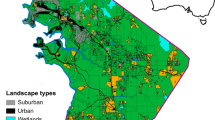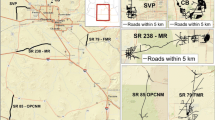Abstract
Urbanization has tremendous impacts on most native species. This is especially true in land snails, which are surprisingly understudied organisms. Due to their low mobility and dispersal potential, land snails are valuable indicators of ecosystem disturbance. For this study, land snails were collected in 54 city parks along an urban gradient to understand impacts of urbanization on snail communities. Sampled parks include small extensively landscaped downtown parks, neighborhood and community parks, district parks, and large nature parks, each with variable vegetation, soil characteristics, disturbance regimes, and human activities. Sampling recovered 12,153 individual snails, representing 20 families, 43 genera, and 95 species. Seven new Tennessee state and 87 new county occurrences were recorded. Five non-native and one extra-limital non-native species were found, four of which are new Tennessee state records. Results show that urbanization greatly alters land snail community structure. Nature and district parks have significantly greater species richness, species diversity and species evenness than community, neighborhood, and downtown parks. Degradation of parks, distance from the park to the commercial city center and percent of coarse woody debris accounted for most of the variation between park types. Non-metric multidimensional scaling and pairwise Jaccard indices indicate that downtown snail communities are more similar whereas snail communities in nature parks are more distinct. This suggests that urbanization promotes homogenization among land snail communities. We also show that this homogenization is thus far driven mainly by synanthropic, broadly adapted native species rather than non-native snail species.







Similar content being viewed by others
References
Adler F, Tanner CJ (2013) Urban ecosystems. Cambridge University press, Cambridge, 382 pp
Aronson MF, La Sorte FA, Nilon CH, Goddard MA (2014) A global analysis of the impacts of urbanization on bird and plant diversity reveals key anthropogenic drivers. Proc R Soc B 281:20133330
Barker GM (2001) Chapter 1: gastropods on land: phylogeny, diversity, and adaptive morphology. In: Barker GM (ed) The biology of terrestrial mollusks. CABI Publishing, New York, pp 1–146
Baur A, Baur B (1988) Individual movement patterns of the minute land snail Punctum pygmaeum (Draparnaud)(Pulmonata: Endodontidae). Veliger 30:372–376
Beyer WN, Saari DM (1977) Effect of tree species on the distribution of slugs. J Anim Ecol 46:697–702
Bergey EA, Figueroa LL (2016) Residential yards as designer ecosystems: effects of yard management on land snail species composition. Ecol Appl 26:2538–2547. https://doi.org/10.1002/eap.1378/full
Burch JB (1955) Some ecological factors of the soil affecting the distribution and abundance of land snails in eastern Virginia. The Nautilus 69:62–69
Burch JB (1962) How to know the eastern land snail. In: William C (ed) Brown Company Publishers, Dubuque, 214 pp
Caldwell RS (1993) Biodiversity and coarse woody debris in southern forests. Proceedings of the workshop on coarse woody debris in southern forests: effects on biodiversity. In: McMinn J, Crossley DA (eds) Macroinvertebrates and their relationship to coarse woody debris: with special reference to land snails. Southern Research Station, Athens, pp 49, 156 pp–54
Chiba S (2010) Invasive non-native species’ provision of refugia for endangered native species. Conserv Biol 24:1141–1147
Chiba S, Roy K (2011) Selectivity of terrestrial gastropod extinctions on an oceanic archipelago and insights into the anthropogenic extinction process. Proc Natl Acad Sci 108:9496–9501
Clergeau P, Noelie T, Benoit F (2011) A simplified method for conducting ecological studies of land snail communities in urban landscapes. Ecol Res 26:515–521
Douglas DD, Brown DR, Pederson N (2013) Land snail diversity can reflect degrees of anthropogenic disturbance. Ecosphere 4:1–14
Dourson DC (2010) Kentucky’s land snails and their ecological communities. Goatslug Publications, Bakersville, NC, 298 pp
Faeth SH, Bang C, Saari S (2011) Urban biodiversity: patterns and mechanisms. Ann N Y Acad Sci 1223:69–81
Fontaine B, Olivier G, Eike N (2007) Priority sites for conservation of land snails in Gabon: testing the umbrella species concept. Divers Distrib 13:725–734
Frest TJ, Johannes EJ (1995) Interior Columbia Basin mollusk species of special concern. Final report: Interior Columbia Basin Ecosystem Management Project, Walla Walla, WA. Deixis Consultants, Seattle, WA. Contract #43-0E00-4-9112. 274 pp
Frest, T.J. (2002). Native snails: indicators of ecosystem health. In: Wuerthner G & Matteson, M. (eds) Welfare ranching. Island Press, Sausalito pp. 211-215
Guette A, Gaüzère P, Devictor V, Jiguet F, Godet F (2017) Measuring the synanthropy of species and communities to monitor the effects of urbanization on biodiversity. Ecol Indic 79:139–154
Horsák M, Juřičková L, Kintrová K, Hájek O (2009) Patterns of land snail diversity over a gradient of habitat degradation: a comparison of three Czech cities. Biodivers Conserv 18:3453–3466
Horsák M, Lososová Z, Čejka T, Juřičková L, Chytrý M (2013) Diversity and biotic homogenization of urban land-snail faunas in relation to habitat types and macroclimate in 32 central European cities. PLoS One 8:e71783
Hotopp KP (2002) Land snails and soil calcium in central Appalachian Mountain Forest. Southeast Nat 1:27–44
Hotopp KP, Pearce T, Nekola JC, Slapcinsky J, Dourson D, Winslow M, Kimber G, Watson B (2013) Land snails and slugs of the mid-Atlantic and northeastern United States. Online Resource: http://www.carnegiemnh.org/science/mollusks/index.html
Hubricht L (1985) The distributions of the native land mollusks of the Eastern United States. Fieldiana, Zoology New Ser: 24, 191 pp
Koleff P, Gaston KJ, Lennon JJ (2003) Measuring beta diversity for presence–absence data. J Anim Ecol 72:367–382
Knop E (2016) Biotic homogenization of three insect groups due to urbanization. Glob Chang Biol 22:228–236
Kruskal J (1964) Nonmetric multidimensional scaling: a numerical method. Psychometrika 29:115–129
Kühn I, Klotz S (2006) Urbanization and homogenization – comparing the floras of urban and rural areas in Germany. Biol Conserv 127:292–300
Lososová Z, Horsák M, Chytrý M, Čejka T, Danihelka J, Fajmon K, Hájek O, Juřičková L, Kintrová K, Láníková D, Otýpková Z (2011) Diversity of Central European urban biota: effects of human-made habitat types on plants and land snails. J Biogeogr 38:1152–1163
Lydeard C, Cowie RH, Ponder WF, Bogan AE, Bouchet P, Clark SA, Cummings KS, Frest TJ, Gargominy O, Herbert DG, Hershler R, Perez KE, Roth B, Seddon M, Strong EE, Thompson FG (2004) The global decline of nonmarine mollusks. Bioscience 54:321–330
McCune B, Grace JB (2002) Analysis of ecological communities. MjM Software Design, Glenden Beach
McKinney ML (2002) Urbanization, biodiversity, and conservation. Bioscience 52:883–890
McKinney ML (2006) Urbanization as a major cause of biotic homogenization. Biol Conserv 127:247–260
McKinney ML (2008) Effects of urbanization on species richness: a review of plants and animals. Urban Ecosyst 11:161–176
Murthy AC, Fristoe TS, Burger JR (2016) Homogenizing effects of cities on North American winter bird diversity. Ecosphere 7:e01216
Olden JD, Rooney TP (2006) On defining and quantifying biotic homogenization. Glob Ecol Biogeogr 15:113–120
Pilsbry HA (1940) Land mollusca of north America (north of Mexico). Volume I, Part II. The Academy of Natural Science of Philadelphia, Philadelphia. pp 575–994
Pilsbry HA (1946) Land mollusca of north America (north of Mexico). Volume II, Part I. The Academy of Natural Science of Philadelphia, Philadelphia, pp 1–520
Pilsbry HA (1948) Land mollusca of north America (north of Mexico). Volume II, Part II. The Academy of Natural Sciences of Philadelphia, Philadelphia, pp 521–1113
Rhodes AM (1998) Method for the preparation and quantification of microscopic charcoal from terrestrial and lacustrine sediment cores. The Holocene 8:113–117
Rouget M, Robertson MP, Wilson JRU, Hui C, Essl F, Renteria JL, Richardson DM (2016) Invasion debt - quantifying future biological invasions. Divers Distrib 22:445–456
Saxton AM (1998) A macro for converting mean separation output to letter groupings in Proc Mixed. In Proc. 23rd SAS Users Group International, SAS Institute, Cary, NC, pp 1243–1246
Seto KC, Guneralp B, Hutyra LR (2012) Global forecasts of urban expansion to 2030 and direct impacts on biodiversity and carbon pools. PNAS 109:16083–16088
Shochat E, Lerman SB, Anderies JM, Warren PS, Faeth SH, Nilon CH (2010) Invasion, competition, and biodiversity loss in Urban Ecosyst. Bioscience 60:199–208
Ström L, Hylander K, Dynesius M (2009) Different long-term and short-term responses of land snails to clear-cutting of boreal stream-side forests. Biol Conserv 142:1580–1587
US Census Bureau (2015) www.census.gov. Accessed 11 Feb. 2016
Vermeulen JJ, Liew TS, Schilthuizen M (2015) Additions to the knowledge of the land snails of Sabah (Malaysia, Borneo), including 48 new species. ZooKeys 531:1–139
Yanes Y (2012) Anthropogenic effect recorded in the live-dead fidelity of land snail assemblages from San Salvador Island (Bahamas). Biodivers Conserv 21:3445–3466
Author information
Authors and Affiliations
Corresponding author
Appendix
Appendix
Rights and permissions
About this article
Cite this article
Hodges, M.N., McKinney, M.L. Urbanization impacts on land snail community composition. Urban Ecosyst 21, 721–735 (2018). https://doi.org/10.1007/s11252-018-0746-x
Published:
Issue Date:
DOI: https://doi.org/10.1007/s11252-018-0746-x




